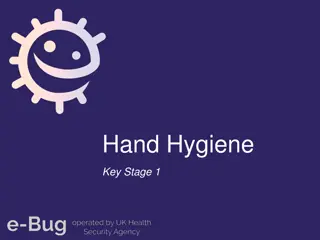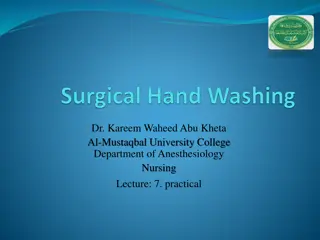
Washing Machine Not Spinning_ Causes, Symptoms, and Solutions
Is your washing machine stuck? Learn the common causes, signs, and practical fixes to get it spinning again quickly.n
Download Presentation

Please find below an Image/Link to download the presentation.
The content on the website is provided AS IS for your information and personal use only. It may not be sold, licensed, or shared on other websites without obtaining consent from the author. Download presentation by click this link. If you encounter any issues during the download, it is possible that the publisher has removed the file from their server.
E N D
Presentation Transcript
Washing Machine Not Spinning: Causes, Symptoms, and Solutions A washing machine that fails to spin can be frustrating, especially when you're expecting clean, dry clothes. The spin cycle plays a crucial role in removing excess water from your laundry, and if it s not working, you may be left with soggy clothes and an incomplete laundry routine. Understanding the causes of a washing machine not spinning, as well as the potential solutions, can help you address this issue effectively. Common Causes of a Washing Machine Not Spinning There are several reasons why your washing machine not spinning, and pinpointing the exact cause is key to finding the right solution. Here are the most common causes of this issue: 1. Unbalanced Load One of the most common reasons for a washing machine not spinning is an unbalanced load. If the clothes are too heavy on one side of the drum, the machine may stop spinning to prevent damage.
2. Lid Switch Problems (Top-Load Washers) For top-load washing machines, a malfunctioning lid switch can prevent the machine from starting the spin cycle. The lid switch is a safety feature that prevents the machine from spinning when the lid is open. 3. Broken Drive Belt The drive belt connects the motor to the drum, enabling the spin cycle. If the belt is broken or slipped off, the washing machine will fail to spin. 4. Faulty Motor Coupling (Top-Load Washers) In some top-load washing machines, a worn-out motor coupling can prevent the drum from spinning. This part connects the motor to the transmission and can wear out over time, especially in older machines. 5. Clogged Drain Pump or Hose If the drain pump or hose is clogged with debris, the washer may not be able to drain the water properly, preventing the spin cycle from starting. The washer will often fail to spin if it detects water in the drum. 6. Defective Motor or Control Board A defective motor or malfunctioning control board can disrupt the spin cycle. If these components fail, the washing machine may not spin or perform other functions correctly. 7. Broken Clutch (Front-Load Washers) Front-load washing machines use a clutch to engage the drum during the spin cycle. If the clutch is broken, the washer won t spin, and the clothes will remain wet after the wash cycle. Symptoms of a Washing Machine Not Spinning Here are some common symptoms that can help you determine if your washing machine is failing to spin: 1. Clothes Are Soaked After the Wash Cycle One of the first signs of a washing machine that s not spinning is excessively wet clothes after the wash cycle is complete. 2. The Drum Doesn t Turn During the Spin Cycle If the drum doesn t rotate at all during the spin cycle, it could be a sign of a mechanical or electrical issue. 3. Unusual Noises or Vibrations If your washer makes strange noises or vibrates excessively during the spin cycle, it could indicate an unbalanced load or a problem with the motor or other components.
4. Error Codes or Lights Many modern washing machines display error codes or flash warning lights when something goes wrong. These codes can often help you pinpoint the cause of the spin cycle failure. Solutions for a Washing Machine Not Spinning Once you've identified the potential cause of the problem, you can apply the appropriate solution: 1. Balance the Load If the load is unbalanced, redistribute the clothes evenly in the drum. Remove any large, heavy items that might be throwing the balance off, such as towels or blankets. 2. Inspect the Lid Switch (Top-Load Washers) If the lid switch is faulty, it may need to be replaced. Test the switch by pressing it with a screwdriver or checking continuity with a multimeter. If it s defective, you ll need to replace it to restore function. 3. Check and Replace the Drive Belt If the drive belt is broken or loose, you ll need to replace it. Disconnect the washer from the power supply, remove the back panel, and inspect the belt. If the belt is damaged, replace it with the correct size for your model. 4. Examine the Motor Coupling (Top-Load Washers) For washers with a motor coupling, inspect it for damage. If the coupling is broken, you ll need to replace it. This repair is usually straightforward, but it might require a professional if you re unsure how to do it. 5. Clear Clogs in the Drain Pump or Hose Inspect the drain pump for clogs, as well as the hose leading from the pump to the drain. Remove any obstructions, and check that the pump operates freely when the washer drains. You may need to clean the pump filter or replace the pump if it's damaged. 6. Test the Motor or Control Board If you suspect a problem with the motor or control board, you may need a professional technician to inspect and replace the faulty parts. Testing and replacing these components often require specialized knowledge and tools. 7. Check and Replace the Clutch (Front-Load Washers) If the clutch is broken in a front-load washer, it will need to be replaced. This can be a more complex repair, so you might want to consider contacting a professional. Preventing Washing Machine Spin Cycle Issues
Regular maintenance can help prevent future spin cycle issues: 1. Avoid Overloading the Washer: Overloading the washer can strain the motor and cause unbalanced loads. Always follow the manufacturer's guidelines for load size. 2. Check and Clean the Drain System Regularly: Clean the drain hose and filter regularly to prevent clogs from forming. 3. Inspect the Washer for Wear and Tear: Periodically check the drive belt, motor, and other components for signs of wear and replace them as necessary. 4. Use Proper Detergent and Settings: Use the right detergent for your machine and set the correct water level for the load size. Final Thoughts If your washing machine is not spinning, it could be caused by a variety of issues, ranging from an unbalanced load to a faulty motor. Diagnosing the problem and taking the necessary steps to fix it will help you avoid further damage and restore your machine to normal operation. For persistent or complex issues, such as problems with the motor, control board, or clutch, CLT Appliance Repairs offers expert assistance. Their professional technicians can diagnose and repair your washing machine s spin cycle problems, ensuring your appliance functions as it should. Site Article: Washing Machine Not Spinning: Causes, Symptoms, and Solutions






















